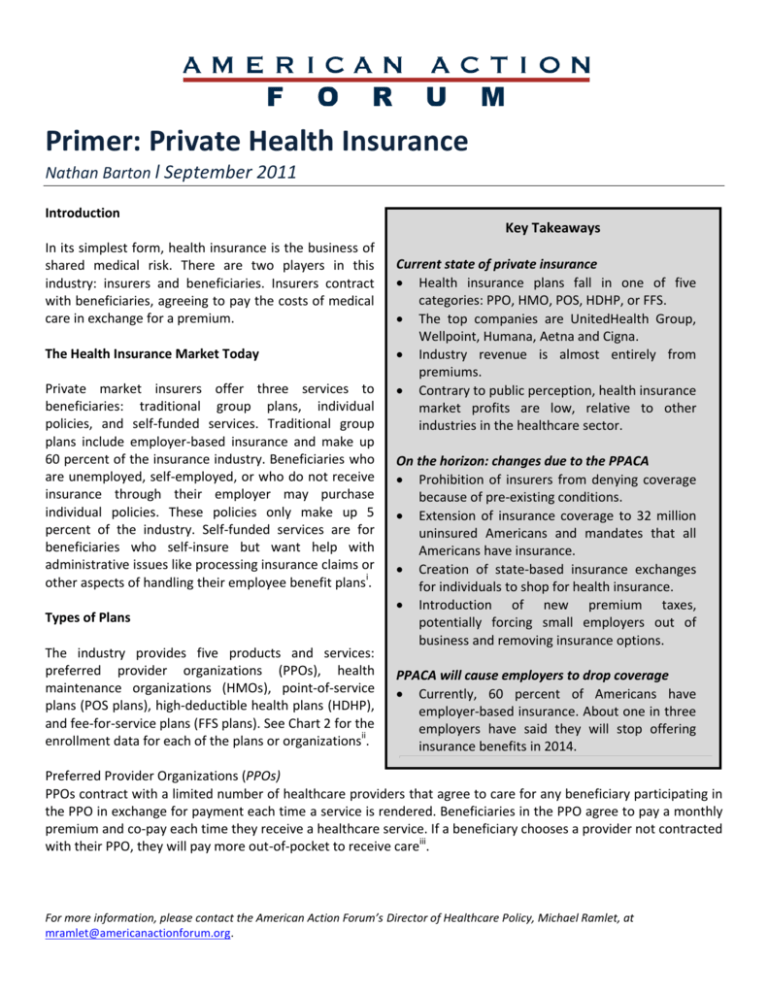Primer: Private Health Insurance
advertisement

Primer: Private Health Insurance Nathan Barton l September 2011 Introduction Key Takeaways In its simplest form, health insurance is the business of shared medical risk. There are two players in this industry: insurers and beneficiaries. Insurers contract with beneficiaries, agreeing to pay the costs of medical care in exchange for a premium. The Health Insurance Market Today Private market insurers offer three services to beneficiaries: traditional group plans, individual policies, and self-funded services. Traditional group plans include employer-based insurance and make up 60 percent of the insurance industry. Beneficiaries who are unemployed, self-employed, or who do not receive insurance through their employer may purchase individual policies. These policies only make up 5 percent of the industry. Self-funded services are for beneficiaries who self-insure but want help with administrative issues like processing insurance claims or other aspects of handling their employee benefit plansi. Types of Plans The industry provides five products and services: preferred provider organizations (PPOs), health maintenance organizations (HMOs), point-of-service plans (POS plans), high-deductible health plans (HDHP), and fee-for-service plans (FFS plans). See Chart 2 for the enrollment data for each of the plans or organizationsii. Current state of private insurance Health insurance plans fall in one of five categories: PPO, HMO, POS, HDHP, or FFS. The top companies are UnitedHealth Group, Wellpoint, Humana, Aetna and Cigna. Industry revenue is almost entirely from premiums. Contrary to public perception, health insurance market profits are low, relative to other industries in the healthcare sector. On the horizon: changes due to the PPACA Prohibition of insurers from denying coverage because of pre-existing conditions. Extension of insurance coverage to 32 million uninsured Americans and mandates that all Americans have insurance. Creation of state-based insurance exchanges for individuals to shop for health insurance. Introduction of new premium taxes, potentially forcing small employers out of business and removing insurance options. PPACA will cause employers to drop coverage Currently, 60 percent of Americans have employer-based insurance. About one in three employers have said they will stop offering insurance benefits in 2014. Preferred Provider Organizations (PPOs) PPOs contract with a limited number of healthcare providers that agree to care for any beneficiary participating in the PPO in exchange for payment each time a service is rendered. Beneficiaries in the PPO agree to pay a monthly premium and co-pay each time they receive a healthcare service. If a beneficiary chooses a provider not contracted with their PPO, they will pay more out-of-pocket to receive careiii. For more information, please contact the American Action Forum’s Director of Healthcare Policy, Michael Ramlet, at mramlet@americanactionforum.org. Figure 1: Types of Private Health Insurance Plans FFS Plans HDHPs 3% 5% POS Plans 13% PPOs 58% HMOs 21% Health Maintenance Organizations (HMOs) HMOs are prepaid health plans that charge monthly premiums and contract with doctors, hospitals, and other healthcare service providers to accept their participants. Typically, if a provider is not contracted with the HMO the service provider will not accept the HMO’s participants. Participants may be required to provide a small co-pay, such as $5 for a doctor visit, or $25 for an emergency room visitiv. In general, HMO providers are paid on a per patient basis rather than for each service. Point-of-Service (POS) Plans Under this plan, beneficiaries receive care from providers contracted with their HMO. Beneficiaries can also receive treatment from non-contracted providers, as long as the needed treatment is covered by the HMO. Additionally, a contracted doctor can recommend that a beneficiary see a doctor or provider who is not a part of the HMO. In this case, the beneficiary is allowed to visit the referred doctor and the HMO will pay the same amountv. High-Deductible Health Plans (HDHP) Figure 2: Major Private Health Insurersvi HDHPs have higher annual deductibles (an amount of Cigna out of pocket costs the beneficiary incurs before the Aetna 2% insurance kicks in) but lower premiums relative to other 5% Humana traditional health plans. They are often combined with 5% Health Savings Accounts (HSAs) or Health Wellpoint Reimbursement Accounts (HRAs). HDHPs provide 9% traditional medical coverage and enables participants to save for future medical expenses. Additionally, participants have greater flexibility and discretion about how they use their healthcare benefits. Participants can UnitedHealth pay deductibles out-of-pocket or with funds from their Group health savings accountsvii. 15% Other viii Fee-for-Service (FFS) Plans Figure 2: Major 64% Private Health Insurers FFS plans are the traditional method insurers pay for healthcare services. Plans pay for specific healthcare services whenever the patient receives that serviceix. www.OperationHealthcareChoice.org Major Insurers The insurance market is segmented with the five major companies controlling 36 percent of the market share. The top firms are UnitedHealth Group, Wellpoint, Humana, Aetna, and Cigna (Figure 2). According to their reports, all of the above companies saw earnings higher than expected in first and second quarters of 2011. One probable reason for the higher profits is the stagnant economy forcing beneficiaries to put off medical care to reduce their out of pocket costs which in turn reduced outlays for insurers. Larger companies are also better able to negotiate down reimbursements and better manage administrative burdens. Economic Impact Since most industry revenue comes from premiums, the market forces that affect premiums also determine revenue levels. There are three key factors that affect revenue through premiums: coverage costs, level of unemployment, and disposable income. Understanding these forces is necessary to understand and or predict industry profitabilityx. First, when coverage costs increase, insurers must increase premiums to raise enough revenue to cover their costs. Second, when unemployment increases, there are fewer people with employer-sponsored insurance. With fewer people enrolled in insurance plans, total revenue from premiums decreases. Lastly, when disposable income increases, more individuals purchase health plans. Other revenues come from administrative fees related to managed care services and medical data management. However, note that an increase in revenue does not mean an increase in profits. The industry’s revenue in 2011 is expected to be $677.3 billion. Its annual revenue growth rate for the past 5 years is 2.7 percent rising to 5 percent over the next 5 years. Figure 3: Comparison of Health Insurance Industry Costs and Average Sector Costs 0.7 3.6 Other 70.3 87.8 Purchases Wages Profit 13.5 4.5 7 12.6 Health insurance industry Average of all industries in sector www.OperationHealthcareChoice.org High Expense, Thin Profits Reports often discuss huge profits in the health insurance markets. After close examination, however, it is clear that is not the case. Insurers actually operate on thin profit margins, relative to other industries. Figure 3 compares operating expenses and profits in the health insurance industry to operating expenses and profits in other industries in the healthcare sector. Strikingly, average profits for all industries in the sector are 12 percent, almost twice as much as the profits in the health insurance industry. In fact, IBISWorld reports that profits in the health insurance industry will decrease over the next 4 years from 7 percent to 4 percentxi. How the Affordable Care Act Affects the Industry The recent healthcare legislation—the Patient Protection and Affordable Care Act (PPACA)—increases insurance coverage to 32 million uninsured Americans. There is a lot of uncertainty as to what the newly enlarged pool of beneficiaries will do to the premium costs. Prohibits insurers from dropping coverage on sick people and from enforcing lifetime coverage and annual limits. Due to the adverse selection problem, many insurers are concerned that they will not be able to provide the same coverage and scope of benefits and stay profitable. Mandates insurance exchanges in each state by 2014. McKinsey recently released a study indicating that 1/3 of 1300 employers would drop employer-sponsored coverage in 2014 as a result.xii This was not expected in original estimates and could drastically raise the cost of paying for PPACA.xiii Introduces new premium taxes, potentially forcing small employers out of business and removing insurance options.xiv Requires that insurers spend 80-85 percent of their revenue on medical care in, known as the “medical loss ratio” (MLR). If insurers fail to MLR standards in 2011, then they will have to issue rebates in 2012xv. Firms are concerned about the additional accounting and compliance costs. www.OperationHealthcareChoice.org The American Action Forum is a forward-looking policy institute. The Forum produces realtime, fact-based, innovative policy analysis and solutions for policy makers and the public alike. Our mission is to promote common-sense, innovative and solutions-based policies that will reform government, challenge outdated assumptions, and create a smaller, smarter government. Operation Healthcare Choice is the Forum’s public policy center focused on promoting highvalue healthcare and higher quality health insurance that expands consumer choice. Operation Healthcare Choice experts conduct research, offer commentary, and develop policies aimed at eliminating healthcare’s burden on the economy. References i ii Andrews RJ. “IBISWorld Industry Report 52411b: Health & Medical Insurance in the US.” August 2011. Ibid. Ibid. iv Ibid. v Ibid. vi Ibid. vii Ibid. viii Ibid. ix Ibid. iii x xi Ibid. xii Ibid. Singhal S, Stueland J, & Ungerman D. “How US health care reform will affect employee benefits.” McKinsey Quarterly. http://www.mckinseyquarterly.com/How_US_health_care_reform_will_affect_employee_benefits_2813. Accessed June 25, 2011. xiii Cook B. “More employers consider dropping health coverage, report says.” http://www.ama-assn.org/amednews/2011/06/20/bisa0620.htm. Accessed June 21, 2011. xiv Holtz-Eakin D. Testimony before the House Committee on Small Business. http://smbiz.house.gov/UploadedFiles/Holtz-Eakin_Testimony.pdf. July 26, 2011. xv National Coalition on Health Care. “HHS Releases the MLR Regulation.” Nov. 22, 2010. http://nchc.org/content/hhs-releases-mlr-regulation. Accessed June 25, 2011. www.OperationHealthcareChoice.org




